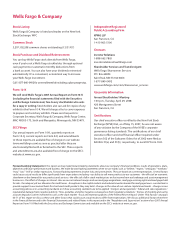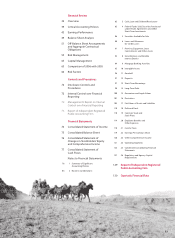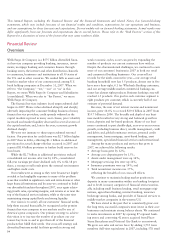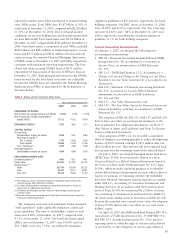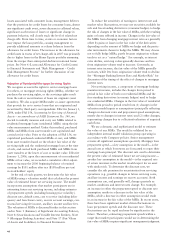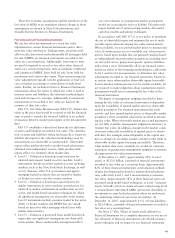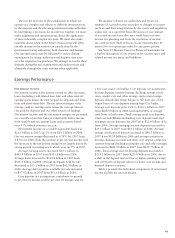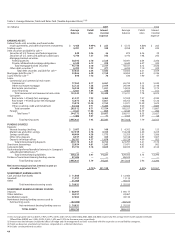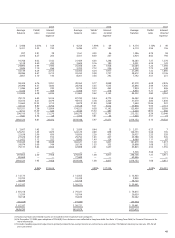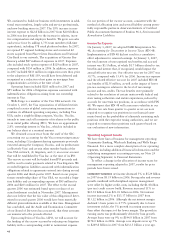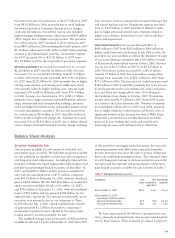Wells Fargo 2007 Annual Report Download - page 42
Download and view the complete annual report
Please find page 42 of the 2007 Wells Fargo annual report below. You can navigate through the pages in the report by either clicking on the pages listed below, or by using the keyword search tool below to find specific information within the annual report.
39
Critical Accounting Policies
Our significant accounting policies (see Note 1 (Summary of
Significant Accounting Policies) to Financial Statements) are
fundamental to understanding our results of operations and
financial condition, because some accounting policies require
that we use estimates and assumptions that may affect the
value of our assets or liabilities and financial results. Five of
these policies are critical because they require management
to make difficult, subjective and complex judgments about
matters that are inherently uncertain and because it is likely
that materially different amounts would be reported under
different conditions or using different assumptions. These
policies govern the allowance for credit losses, the valuation
of residential mortgage servicing rights (MSRs) and finan-
cial instruments, pension accounting and income taxes.
Management has reviewed and approved these critical
accounting policies and has discussed these policies with
the Audit and Examination Committee.
Allowance for Credit Losses
The allowance for credit losses, which consists of the
allowance for loan losses and the reserve for unfunded credit
commitments, is management’s estimate of credit losses
inherent in the loan portfolio at the balance sheet date. We
have an established process, using several analytical tools and
benchmarks, to calculate a range of possible outcomes and
determine the adequacy of the allowance. No single statistic
or measurement determines the adequacy of the allowance.
Loan recoveries and the provision for credit losses increase
the allowance, while loan charge-offs decrease the allowance.
PROCESS TO DETERMINE THE ADEQUACY OF THE ALLOWANCE
FOR CREDIT LOSSES
While we attribute portions of the allowance to specific
loan categories as part of our analytical process, the entire
allowance is used to absorb credit losses inherent in the total
loan portfolio.
A significant portion of the allowance is estimated at a
pooled level for consumer loans and some segments of com-
mercial small business loans. We use forecasting models to
measure the losses inherent in these portfolios. We validate
and update these models periodically to capture recent
behavioral characteristics of the portfolios, such as updated
credit bureau information, actual changes in underlying
economic or market conditions and changes in our loss
mitigation strategies.
The remaining portion of the allowance is for commercial
loans, commercial real estate loans and lease financing. We
initially estimate this portion of the allowance by applying
historical loss factors statistically derived from tracking losses
associated with actual portfolio movements over a specified
period of time, using a standardized loan grading process.
Based on this process, we assign loss factors to each pool of
graded loans and a loan equivalent amount for unfunded
loan commitments and letters of credit. These estimates are
then adjusted or supplemented where necessary from additional
analysis of long-term average loss experience, external loss
data or other risks identified from current conditions and
trends in selected portfolios, including management’s judgment
for imprecision and uncertainty. We assess and account for
as impaired certain nonaccrual commercial and commercial
real estate loans that are over $3 million and certain consumer,
commercial and commercial real estate loans whose terms
have been modified in a troubled debt restructuring. We
include the impairment on these nonperforming loans in the
allowance unless it has already been recognized as a loss.
Reflected in the two portions of the allowance previously
described is an amount for imprecision or uncertainty that
incorporates the range of probable outcomes inherent in
estimates used for the allowance, which may change from
period to period. This amount is the result of our judgment
of risks inherent in the portfolios, economic uncertainties,
historical loss experience and other subjective factors, including
industry trends, calculated to better reflect our view of risk
in each loan portfolio.
The total allowance reflects management’s estimate of
credit losses inherent in the loan portfolio at the balance sheet
date. To estimate the possible range of allowance required at
December 31, 2007, and the related change in provision
expense, we assumed the following scenarios of a reasonably
possible deterioration or improvement in loan credit quality.
Assumptions for deterioration in loan credit quality were:
• for consumer loans, a 23 basis point increase in estimated
loss rates from actual 2007 loss levels, moving closer to
longer term average loss rates or more prolonged stress
case for home equity loans; and
• for wholesale loans, a 24 basis point increase in estimated
loss rates, moving closer to historical averages.
Assumptions for improvement in loan credit quality were:
• for consumer loans, an 18 basis point decrease in estimated
loss rates from actual 2007 loss levels, adjusting for the
elevated home equity losses and an improving real estate
market for consumers; and
• for wholesale loans, nominal change from the 2007 net
credit loss performance.
Under the assumptions for deterioration in loan credit
quality, another $804 million in expected losses could occur
and under the assumptions for improvement, a $416 million
reduction in expected losses could occur.
Changes in the estimate of the allowance for credit losses
and the related provision expense can materially affect net
income. The example above is only one of a number of rea-
sonably possible scenarios. Determining the allowance for
credit losses requires us to make forecasts of losses that are
highly uncertain and require a high degree of judgment.
Given that the majority of our loan portfolio is consumer
loans, for which losses tend to emerge within a relatively
short, predictable timeframe, and that a significant portion
of the allowance for credit losses relates to estimated credit





